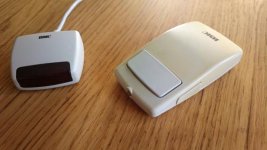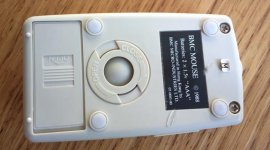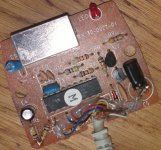Great find, John! It turns out that we'll need to move this to the Peripherals forum:
I've been looking for mine on and off since you posted this yesterday and I just found it. It's the two-button 1989 version with the manual
and the ADB converter! It's just a simple cable converter, so they appear to have implemented ADB on the unused contacts of the DE-9 connector to carry the ADB signal(s) to support the "Macintosh II, SE and Plus" as the cover of the Manual states. The Macintosh_II/SE release was 1987.03.02, so I imagine that yours will have ADB capability as well. I'll buzz the connections on the adapter and you can check for activity on the ADB lines. The major change between versions is the addition of a right click button. Halving that big mono-button makes it look a bit sportier and be a little more useful. Unless the II/SE have built in support for the right click, a driver needs to be found for the second click to be useful, my friend didn't include a floppy with the near complete package.
When I worked out a trade, I wouldn't have offered this gem had I recalled that it was compatible with my Plus collection. This baby would have been connected to the Plus converted Drexel Mac/MicroMac'030 so fast it's little mouse head would have spun! You're a lucky guy Cosmo! [

] ]'> I've been trying to find time to document this before offering it up to the freight eating gods lying in wait between here and Finland. I need to put some batteries in there to test it again as well, it's been lying dormant in a Zip-Loc bag for over ten years . . .
. . . while I procrastinated a bit about documenting it. :

The only other difference I can see would be the nubbin on the bottom of your mouse, John. As for the button on the side, try holding it down whilst moving the mouse quickly and then doing so while moving it slowly. That's the "Non-Linear Move Switch" The mouse has multi-speed tracking. Use that "extra key to control the moving speed of the cursor from ultra fine displacement to very high speed movement."
Try Googling "MOBIUS Technologies Inc." along with BMC for info on your bobtail rodent. That trademarking is on white stickers, front and back, covering metallic silver (shiny/opaque) stickers, so that info remains secret until Cosmo has a chance to remove one of the white MOBIUS stickers.
The back of manual says: © 1989 BMC________ PRINTED IN HONG KONG
So my guess is that these were OEM'd in Hong Kong and first marketed by a company acquired wholesale by MOBIUS or from whom they bought distribution rights to the product.
Neat stuff! :approve:
BTW, even I wouldn't hack this little baby, they're scarce as hen's teeth, I've never seen hide nor hair of them in that ten years. Put some Velcro on it and your Plus and display it proudly . . .
. . . I've procrastinated about getting the hook half for mine as well. :lol:






